Ethereum developers have recently introduced a new testnet called “Holešky” on September 15th. This testnet is specifically designed for staking, infrastructure, and protocol development purposes, as stated in the developer documents. While Sepolia continues to dominate in application development, Holešky aims to address the testing needs by providing a significant initial supply of testnet Ether (HETH). In this article, we will explore the features and potential benefits of the new testnet and its implications for Ethereum developers.
To kickstart the operation of the Holešky network, an initial supply of 1.6 billion HETH will be allocated to validators on its launch day. This allocation is ten times higher than the amount of Ether (ETH) present on the mainnet. According to Tim Beiko, an Ethereum developer, this decision was made based on the comfort level of developers who have regularly utilized a 10 billion supply in devnets. This significant increase in supply is expected to facilitate extensive testing, making Holešky advantageous for developers.
Before the launch of Holešky, the Goerli testnet served as the primary platform for new staking, infrastructure, and protocol developments. However, concerns arose regarding the insufficient supply of Goerli ETH, hindering effective testing. As a result, the Ethereum team actively encouraged the application developers to transition from Goerli to Sepolia, leaving only the protocol developers on the old network. Holešky aims to address this problem by providing a large initial supply of HETH, ensuring that testing requirements are met effectively.
With the launch of Holešky, Ethereum developers have set their sights on an ambitious roadmap. Their plans include implementing features such as proto-danksharding, danksharding, and Verkle trees. These features are expected to reduce transaction fees and make running a node more cost-effective. By providing an environment focused on staking and protocol development, Holešky plays a crucial role in testing and fine-tuning these upcoming features.
Since its launch in 2021, the Sepolia network has been the preferred platform for application developers, indicating the Ethereum team’s commitment to a smooth transition. Goerli, on the other hand, is slated for deprecation in January 2024. Although it will be maintained for an additional year after deprecation, the network will eventually be shut down entirely, as outlined in the documentation. Therefore, developers are encouraged to transition to Holešky and Sepolia to stay up-to-date with the latest advancements and ensure efficient development practices.
The introduction of Holešky testnet brings forth an exciting opportunity for Ethereum developers, offering a dedicated platform for staking, infrastructure, and protocol development. With its substantial initial supply of HETH, it aims to address the testing needs effectively. Developers can now leverage this testnet to test and refine upcoming features that are anticipated to enhance Ethereum’s scalability and cost-efficiency. As the Ethereum ecosystem evolves, transitioning to testnets like Holešky and Sepolia becomes essential to stay at the forefront of innovation in this expanding blockchain network.

